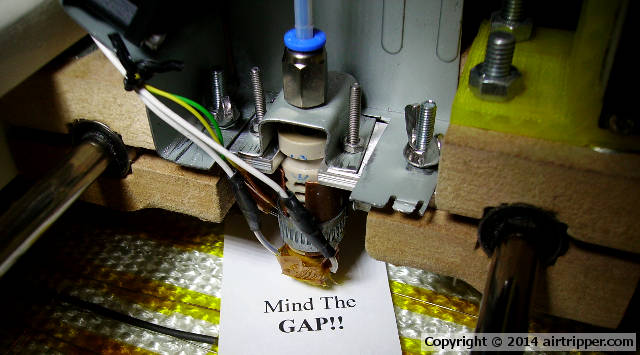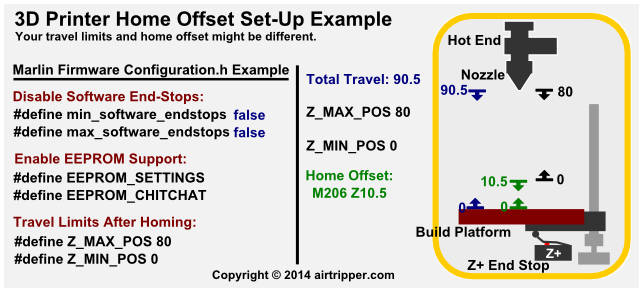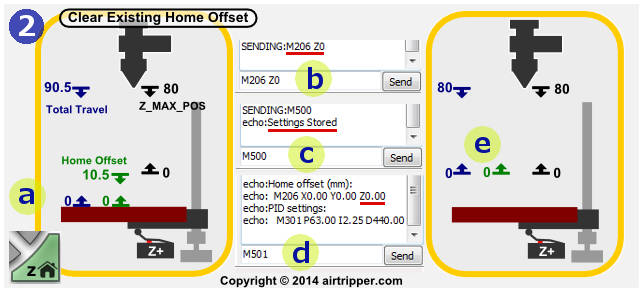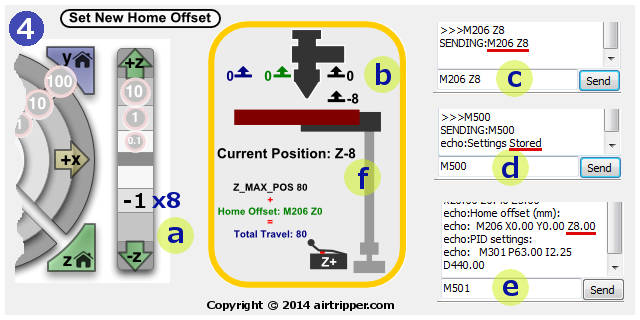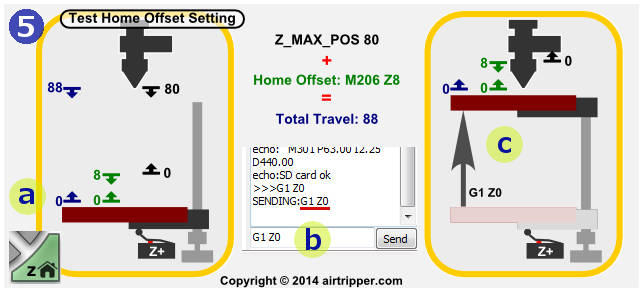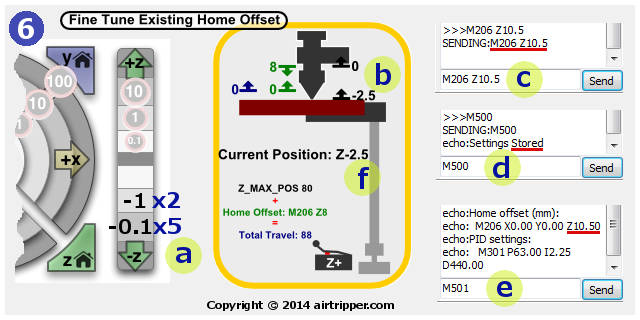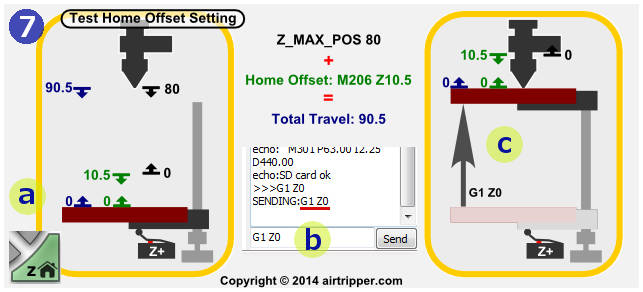Set home offsets что это
Дополнительные настройки в Marlin
Подпишитесь на автора
Подпишитесь на автора, если вам нравятся его публикации. Тогда вы будете получать уведомления о его новых статьях.
Отписаться от уведомлений вы всегда сможете в профиле автора.
Статья относится к принтерам:
На ресурсе есть практически исчерпывающий материал по основным настройкам Marlin. Но дополнительные настройки там затронуты вскользь, и я решил восполнить это упущение. В английский умеют не все, поэтому представляю авторский перевод.
Дополнительные настройки термоконтроля горячего стола:
#define BED_HYSTERESIS 2 //просто выключает подогрев стола, если T>*целевая температура*+BED_HYSTERESIS и включает его, если T B F
Целевая температура устанавливается в значение мин_температура+фактор*se[шагов/сек] и ограничивается в пределах мин_температуры и макс_температуры
Отключается с помощью ввода команды М109 без F. Также, если температура установлена в ‘мин_температура’, то она не меняется с помощью этой функции
#define AUTOTEMP_OLDWEIGHT 0.98
Показ ADC-значений температуры. Команда M105 вместо привычной информации выдаст ADC-значения, прочитанные с датчиков температуры
Предотвращение износа экструдера. Если принтер простаивает, и температура выше, чем MINTEMP, экструдер будет выдавливать некоторое количество филамента с периодом, указанным в параметре SECONDS
#define EXTRUDER_RUNOUT_MINTEMP 190
#define EXTRUDER_RUNOUT_SECONDS 30.
#define EXTRUDER_RUNOUT_ESTEPS 14. //мм филамента
#define EXTRUDER_RUNOUT_SPEED 1500. //скорость экструзии
#define EXTRUDER_RUNOUT_EXTRUDE 100
Это поможет откалибровать датчик AD595, в случае, если он неправильно измеряет температуру.
измеряемая температура определяется как ‘текущая_температура = (измеренная температура * TEMP_SENSOR_AD595_GAIN) + TEMP_SENSOR_AD595_OFFSET’
#define TEMP_SENSOR_AD595_OFFSET 0.0
#define TEMP_SENSOR_AD595_GAIN 1.0
Эта функция отвечает за контроль над вентилятором охлаждения драйверов ШД. Как подключить доп.вентиляторы читайте здесь. Вентилятор будет включаться тогда, когда хотя бы один из драйверов будет активен и выключаться через установленное время после отключения последнего драйвера.
#define CONTROLLERFAN_SECS 60 //Сколько секунд будет вращаться вентилятор после отключения последнего драйвера
#define CONTROLLERFAN_SPEED 255 // == полная скорость. Можно поставить меньше, если задействованы выходы с PWM.
При первом старте вентилятора он запускается на полной скорости на некоторое время. Это дает уверенный старт перед установлением пониженного PWM-значения (не работает с программным PWM на Sanguinololu). Примечание: это правило, возможно, действительно только для того вентилятора, который включается по команде M106
#define FAN_KICKSTART_TIME 100 //кол-во мс полной скорости
Вентиляторы охлаждения тепловых барьеров экструдеров. Настройте пины-выходы для автоматического включения/выключения, когда соответствующий экструдер достигает температуры выше/ниже указанной в параметре EXTRUDER_AUTO_FAN_TEMPERATURE. Несколько экструдеров могут быть назначены на один и тот же пин, и вентилятор будет включаться тогда, когда любой из экструдеров достигает указанной температуры. О подключении доп.вентиляторов, опять же, смотрите здесь.
#define EXTRUDER_0_AUTO_FAN_PIN 4 (-1 для отключения)
#define EXTRUDER_AUTO_FAN_TEMPERATURE 50
#define EXTRUDER_AUTO_FAN_SPEED 255 // == полная скорость. Можно поставить меньше, если задействованы выходы с PWM.
При включении этой настройки концевые выключатели используются только для парковки
Включает драйвер ШД оси Z в последний момент. Нужна в случае перегрева соответствующего драйвера ШД.
Обычно используется один драйвер ШД для управления двумя моторами на оси Z. Раскомментируете для использования раздельных драйверов на каждый ШД Z-оси. Такую функцию поддерживают лишь некоторые платы, например, RAMPS, у которой есть поддержка 2 экструдеров (используется второй, обычно неиспользуемый драйвер ШД) Пины управления указаны для RAMPS, в случае другой платы исправьте их на свои. На 5-драйверной плате включение этой функции ограничит вас возможностью использования только одного экструдера
То же самое для Y-оси
Раскомментируйте, если есть необходимость, чтобы ШД по Y врашались в разные стороны
#define INVERT_Y2_VS_Y_DIR true
Функция поддержки принтеров с двойной Х-кареткой. Подобная конструкция имеет преимущество, т.к. неактивный экструдер может быть запаркован, что предотвратит вытекание горячего пластика из сопла, который загрязняет печать. Также это снижает общий вес каждой Х-каретки, позволяя печатать с более высокими скоростями
Конфигурация для второй Х-каретки
#define X2_MIN_POS 80 // устанавливает минимальное расстояние, при котором вторая Х-каретка не задевает запаркованную первую Х-каретку
#define X2_MAX_POS 353 // максимальное расстояние между соплами, когда обе каретки запаркованы
#define X2_HOME_DIR 1 // вторая каретка всегда паркуется в концевой выключатель максимальной позиции
Однако в этом режиме значение EXTRUDER_OFFSET_X для второго экструдера предоставляет программное переопределение для X2_HOME_POS. Это также позволяет выполнить рекалибровку расстояния между концевыми выключателями без модификации прошивки (через команду M218 T1 Xn).
Помните: вы должны установить смещение второго экструдера равным нулю в вашем слайсере.
Пины для драйвера ШД второй Х-каретки (задаются здесь, чтобы не усложнять pins.h)
#define X2_ENABLE_PIN 29
#define X2_STEP_PIN 25
#define X2_DIR_PIN 23
Есть несколько режимов движения для двойной Х-каретки, которые можно выбирать через команду M605 S
Режим 0: Полный контроль. Слайсер полностью контролирует обе Х-каретки и может достичь оптимальных траекторий, но только если он поддерживает двойные X-каретки. (M605 S0)
Режим 1: режима авто-парковки. Прошивка будет автоматически парковать и снимать с парковки Х-каретки при ‘смене инструмента’, поэтому отдельная поддержка слайсером не требуется. (M605 S1)
Режим 2: режим дупликации. Прошивка будет копировать все действия первой каретки второй кареткой. Это позволяет печатать 2 одинаковых модели одновременно. (смещение по X и разница температур задается как M 605 S2 [Xnnn] [Ryyy]. Обратите внимание, что параметр R, отвечающий за температуру, задается в относительных величинах. Например, при значении R2 второй объект будет напечатан пластиком, нагретым на 2 градуса выше).
Эта строка определяет режим по умолчанию для двойной Х-каретки, который может быть позже сменен командой М605.
#define DEFAULT_DUAL_X_CARRIAGE_MODE 0
Настройки по умолчанию в режиме авто-парковки
#define TOOLCHANGE_PARK_ZLIFT 0.2 // величина подъема Z при парковке экструдера
#define TOOLCHANGE_UNPARK_ZLIFT 1 // величина подъема Z при снятии с парковки экструдера
Смещение по умолчанию для оси Х в режиме дупликации (обычно устанавливается в половину ширины печатной области)
#define DEFAULT_DUPLICATION_X_OFFSET 100
При парковке каретка каждой из осей активирует концевой выключатель, а затем отъезжает обратно на указанную ниже дистанцию прежде, чем медленно запарковаться снова:
#define X_HOME_RETRACT_MM 5
#define Y_HOME_RETRACT_MM 7
#define Z_HOME_RETRACT_MM 3
#define QUICK_HOME //при активации этого параметра по команде G28 X Y оси одновременно совершат парковку, а не по отдельности.
Отсчет в относительных величинах для осей X, Y, Z, E
По умолчанию драйверы на основе А4988 требуют сигнал высокого уровня для шага. Однако, некоторые мощные драйверы могут требовать сигнал низкого уровня. Инверсия сигналов делается установлением параметра в true:
#define INVERT_X_STEP_PIN false
#define INVERT_Y_STEP_PIN false
#define INVERT_Z_STEP_PIN false
#define INVERT_E_STEP_PIN false
Время, по истечению которого отключаются драйверы ШД в простое. Выставьте 0 для отключения.
#define DEFAULT_STEPPER_DEACTIVE_TIME 60
Подачи для ручных движений с панели (X Y Z E) (для ultipanel)
#define MANUAL_FEEDRATE // устанавливает скорость для ручных движений (мм/мин)
Если файл распечатан, то функция отключает все шаговики
#define SD_FINISHED_STEPPERRELEASE true
Возможно, ось Z нужно будет удерживать, поэтому оси можно отключить по отдельности
#define SD_FINISHED_RELEASECOMMAND ‘M84 X Y Z E’
Функция для съемки процесса печати
#define CHDK 4 //пин для срабатывания CHDK, чтобы сделать фото. Как этим пользоваться см. здесь.
#define CHDK_DELAY 50 //насколько долго в мс пин будет находиться в логической единице перед переходом в ноль
Показывать полосу прогресса печати на дисплеях HD44780 при печати с SD
(только для функции #define LCD_PROGRESS_BAR)
Определяет, сколько времени в мс будет показыватьсяполоса
#define PROGRESS_BAR_BAR_TIME 2000
Определяет, сколько времени в мс будет показываться сообщение статуса
#define PROGRESS_BAR_MSG_TIME 3000
Время (мс) удержания статус-сообщения (0=навсегда)
#define PROGRESS_MSG_EXPIRE 0
Раскомментируйте это для того, чтоюы сообщений показывались в течение времени MSG_TIME, а потом скрывались
Аппаратный ‘наблюдатель’ перезагрузит контроллер и отключит все выходы, если прошивка зависнет и не сможет выполнять регулировку температуры
Если у вас случилась перезагрузка ‘наблюдателем’ в Arduino Mega2560, то устройство будет висеть ‘вечно’, т.к. перезагрузка ‘наблюдателем’ оставляет самого ‘наблюдателя’ включенным. Функция ‘WATCHDOG_RESET_MANUAL’ обходит это, не используя аппаратную перезагрузку. Однако, ЭТА ФУНКЦИЯ НЕБЕЗОПАСНА и будет работать только в том случае, если прерывания отключены. И код может зависнуть при выполнении прерывания с отключенными прерываниями.
Включает опцию остановки печати с SD при срабатывании концевых выключателей, требует включения через меню LCD-экрана при активации в прошивке.
Babystepping позволяет пользователю двигать осями в небольших пределах независимо от обычного процесса печати. Например, это может быть использовано для смены высоты по Z в реальном времени. Не зависит от концевых выключателей!
#define BABYSTEP_XY //не только по Z, но также и по XY в меню
#define BABYSTEP_INVERT_Z false //true для инверсии движений по Z
#define BABYSTEP_Z_MULTIPLICATOR 2 //более быстрые движения по Z
Адванс-константа экструдера. Или Velocity-режим экструдера. (Extruder advance constant (s2/mm3)) Эта настройка должна помочь избавиться от капель на периметрах детали при печати, может быть полезна для Bowden-экструдеров. Подробнее здесь, здесь, здесь и здесь Вкратце о ее работе: экструдер начинает и прекращает давить пластик несколько раньше, чтобы давление в сопле успевало нарастать и спадать в нужное время. Подобная функция есть в Slic3r и, возможно, других сласерах.
#define STEPS_PER_CUBIC_MM_E (количество шагов экструдера/площадь экструзии)
И еще несколько интересных строк из configuration.h:
Увеличение частоты ШИМ вентилятора. Убирает назойливый звук, гл увеличивает нагрев мосфета/микроконтроллера
Использование программного PWM для управления вентилятором, как и для подогревателей. При этом используется очень низкая частота, которая не так раздражает (звуком). С другой стороны, если частота слишком мала, ее нужно увеличить параметром SOFT_PWM_SCALE.
#define SOFT_PWM_SCALE 0
Еще одна функция для съемки процесса печати (активация командой M240) через эмуляцию Canon RC-1 Remote. Подробнее здесь #define PHOTOGRAPH_PIN 23
Поддержка кондитерского экструдера BariCUDA #define BARICUDA
Наиболее полезные, на мой взгляд, функции:
#define EXTRUDER_0_AUTO_FAN_PIN 4
Пара мелочей, которые, возможно, будут нужны при использовании вентилятора обдува на низкой скорости
#define FAN_KICKSTART_TIME 100
Можно поиграться с величиной ретракта при парковке, чтобы чуточку ускорить этот процесс
#define X_HOME_RETRACT_MM 5
#define Y_HOME_RETRACT_MM 7
#define Z_HOME_RETRACT_MM 3
Эта команда значительно ускоряет парковку
Уже неоднократно перезапускал печать из-за неправильного значения z-offset. С помощью этой функции можно будет в реальном времени опустить каретку и не перезапускать печать снова
Эта функция, вероятно, поможет побороться с рассинхроном Z-оси на Prusa i3
Настройки filament sensor’а не стал включать потому, что им будет посвящена отдельная статья.
Подпишитесь на автора
Подпишитесь на автора, если вам нравятся его публикации. Тогда вы будете получать уведомления о его новых статьях.
Отписаться от уведомлений вы всегда сможете в профиле автора.
Marlin Firmware Home Offset Guide Using G-code M206
This is a guide to using g-code command M206 to set the Z axis home offset in the Marlin Firmware, a guide to a method of adjusting the gap distance between the hot end nozzle and the build platform. To set the Z axis home offset on the 3d printer, you will use g-code commands including M206 for the home offset, M500 and M501 for the Marlin Firmware EEPROM feature, and G1 for controlled move to Z axis zero position.
Set Gap Between Nozzle And Bed Using G-Code, EEPROM & Marlin Firmware
About
Firstly, this guide may not be suitable for all 3d printers, probably those printers that are the delta type and those with the auto bed levelling feature. Apart from that, for this guide to work for you, you will need a 3d printer configured with a Z+ end stop.
On a lot of 3d printer set-ups, the gap between the nozzle tip and the build platform surface is just a fraction of a millimetre, so it does not take much to upset the gap distance. Things like levelling the build platform, changing the hot end nozzle and using different filament types can cause the first layer height to be out of calibration.
Usually, as accurately as possible, you would only adjust the final travel limit for Z axis in the Marlin Firmware, then upload the firmware to the controller motherboard. However, if adjustments are going to be made more often, it would be more convenient to adjust the final travel limit using the home offset feature.
The guide will explain a method of applying an offset to the Z axis to extend the maximum travel limit, initially set in the Marlin Firmware, using Pronterface. A combination of g-codes will be used through Pronterface so that the home offset can be set, saved and tested. An initial edit in the Marlin Firmware configuration.h file is required, but beyond that, you would only need to change the home offset value to change the gap distance between the hot end nozzle and the 3d printer build platform.
3D Printer Axis Crash Caution – Axis crash is possible with manual jog when software end-stops are disabled
Removed Safeguards – Important
This guide, an extension to the Marlin Firmware v1, Basic Configuration Set-up Guide, covers editing the Marlin Firmware configuration.h file to enable EEPROM support and to disable software end-stops, and as a result of editing the configuration file, it will be important to note that some operational safeguards will be disabled; it will be possible to manually jog an axis beyond its travel limits, probably resulting in an axis crash and possibly causing damage. Accidentally pressing the 100mm jog button instead of the 10mm jog button, is an example of what could cause a 3d printer axis crash; this would normally be prevented by enabled software end-stops. Attempting to print models outside the physical print area could also cause an axis crash also.
Only use this method to set home offset, as described in this guide, if the users of your 3d printer are aware of the manual jog limits and the risk of crashing an axis when exceeding the limits. It would be recommended to include axis homing to the g-code compiler start file so that homing is automatically applied to the model g-code files at compile time. It would be good practice to manually home the 3d printer, using the printer interface such as Cura or a printer control interface, before starting each print.
Marlin Firmware Configuration
If you are attempting to configure the Marlin Firmware for the first time you will need to head over to the Marlin Firmware set-up guide here to get started with the basics.
It’s basically going to be a quick edit of the Configuration.h before we get started with the main guide to configuring the home offset. Use the Arduino IDE search tool to quickly find the lines of code needed for editing.
3D Printer Marlin Firmware & Home Offset Set-up Example
Disable Software End-Stops
To configure the home offset successfully, we’ll need to be able to travel beyond the fixed travel limits set in the Marlin Firmware. When software end-stops are enabled, the home offset will not work outside the axis travel limits. If we want the axis to travel to maximum position plus home offset, we will need to disable software end-stops.
#define min_software_endstops false
#define max_software_endstops false
Software end-stops are enabled by default. To disable software end-stops, find the above lines of code in Marlin Firmware Configuration.h file and set each line to false as shown.
Enable EEPROM Suport
After setting the Z axis home offset on the 3d printer, we want to store the setting in EEPROM so that the home offset value we want to use is available automatically when the printer is started.
#define EEPROM_SETTINGS
#define EEPROM_CHITCHAT
To enable EEPROM support in the Marlin Firmware, uncomment the above code snippets by removing the forward slashes at the start of each line of code.
Travel Limits After Homing
Ideally, we want to set a maximum travel limit that stops the hot end a good safe distance above the build platform with home offset set to zero, and then fill the gap between the nozzle and the build platform with home offset. If you change the build platform thickness by adding a glass surface for PLA and then remove glass surface for ABS, you will have to allow for the thickness of the glass also. A guide to clearing the current home off set is included further down this article.
#define Z_MAX_POS 80
Normally, you will only need to change the value for Z_MAX_POS; just edit the above line of code to the maximum travel limit you want to set for your 3d printer. On my 3d printer for example, I have around 90mm of travel on the Z axis, as shown in the above code, I’ve set the Z_MAX_POS to 80, that leaves around 10mm to play with when setting the home offset.
Marlin Firmware Home Offset Guide
Some Preparation
After the Marlin Firmware is configured as above, the build platform needs to be levelled before attempting to set the Z axis home offset. You will need to be prepared to fine tune the final offset measurement while the hot end and the heated build platform are up to working temperature. You can practice setting the home offset while the 3d printer is cold, this will avoid trial and error while the nozzle is hot and not extruding for long length of time.
Pronterface – 3D Printer Interface Software
Setting home offset and storing to EEPROM is done through the 3d printer interface software such as Cura and Pronterface. Both Cura and Pronterface have a terminal interface that allow the user to send g-code commands to the Marlin Firmware. For this guide, Pronterface will be used because manual jog controls and terminal are in the same application window for convenience.
Terminal inputs may be case sensitive in some 3d printer software interfaces, if you get an error or no response in the terminal feedback window, check that you are typing upper-case g-code commands.
Setting & Testing Home Offset
Quick Brief
There are seven steps to follow in this guide, first two steps will be to check and clear existing offset for the Z axis, followed by five steps to set and test new home offset. If you are using the Marlin Firmware home offset feature for the first time, please be sure to read through the whole guide first before changing any settings.
The guide describes a set-up that is similar to my 3d printer only, so the Z axis measurements used in this guide are there as a set-up example and not meant to be copied for use in other 3d printer set-ups. If you’ve read the guide in full, you’ll have an idea of what measurements to use on your 3d printer to set your own home offset.
Checking & Clearing Existing Home Offset
Saving a new home offset setting will replace a previously saved offset in EEPROM, so if you’re using a 3d printer you’re not familiar with, avoid unexpected results by first checking for existing offset setting. The next two steps will help to discover and clear an existing offset.
Step 1. This is a simple check to see if an offset has been set.
Check Current Home Offset Setting Stored In EEPROM
Step 2. You can fine tune existing offset by jumping to later steps, or you can start a fresh by setting offset to Zero.
Step 2 – Clear Existing 3D Printer Z Axis Home Offset
Setting The Initial Home Offset – 3D Printer Cold
This part of the guide describes setting up an initial home offset while the printer is cold. Basically, we are setting a new offset that will be a centimetre or two short of what we need, we will get the hot end nozzle close to the build platform while the printer is cold. Then, later in this guide, we heat up the 3d printer for fine tuning the final offset.
Step 3. We prepare the printer for the next step so that an initial offset can be measured.
Step 3 – Test Z Axis Height & Z Travel Distance
Step 4. So, moving forward from Step 3. c, we are now going to set a rough home offset value with the 3d printer cold, no heaters switched on. If you are just fine tuning the final home offset value, you could probably skip to Step 5.
If you have a mirrored or glass build platform, slide a sheet of paper over the platform to avoid hot end nozzle reflection that can make you think the gap between the nozzle and platform is bigger than it actually is. If you prefer, centre X and Y axis over the build platform before measuring the gap between hot end nozzle and build platform.
Step 4 – Set New Home Offset For Z Axis
Step 5. A new home offset value has been saved to EEPROM, and confirmed. Now it’s time to mechanically test the new offset before moving on to fine tuning. The 3d printer is still cold at this point, however, the build platform can be preheated now if preferred, especially if the platform takes a long time to heat up.
Step 5 – Test New Home Offset Setting
Fine Tuning The Initial Home Offset – 3D Printer Hot
Step 6. If you are jumping straight into fine tuning, you need to start from step 5. Right, we’re on to fine tuning the home offset now. This is were you need to be careful, because it is recommended to have the hot end and the build platform at working temperatures while setting the first layer height or gap between the nozzle and platform.
I use A4 photocopy or printer paper as a gap feeler for setting the gap between the nozzle and the platform. You may need to cut the A4 sheet to fit inside the printer, but have the sheet at a size so that it can be handled and positioned while avoiding hands and fingers touching the hottest parts of the 3d printer.
Step 6 – Fine Tune Existing Home Offset Setting
Part 7. By now, the home offset should be ready for the first 3d print test, all we need to do now is test the offset setting, like in step 5, just to confirm we are ready to go. Once the following test is complete, home the 3d printer, and switch off the heated bed and the hot end nozzle heater.
Step 7 – Test Final Home Offset Setting
Closing Notes
I hope you found this guide useful, A lot of care was made to avoid mistakes, but if you find any please let me know.
The graphical illustrations should provide a quick guide for return visits to jog the memory when needing to set a new home offset. If you are feeling confident and you find the 3d printer interface software jog controls don’t give you enough fine tuning, use the G1 controlled move command.
Related Articles
Marlin Firmware Home Offset Guide Using G-code M206
